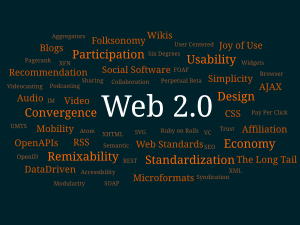 Image via Wikipedia
Image via WikipediaI have just finished working on a mindmap that tells the story of Susie and her use of Web 2.0 tools to conduct research for her assignments. The mindmap: Susie Web 2.0 Research is designed to give an idea of the complex web of information, ideas, sharing, evaluation and analysis that can go on (in an ideal world) when the potential of the Web 2.0 is exploited fully.
The Scenario
Susie is studying at Unitec NZ for a Bachelor of Architectural Studies. She is in her second year and has just received the rubric for her next assignment, which is a paper that focuses on analysing architectural sites, discussing a hypothetical development, which demonstrates, for example how to ensure the environmental sustainability of the project.
Susie and her classmates initially sit around with their laptops and discuss strategies, ideas, and deadlines. They set up a Mindmeister mindmap and make sure that it has been shared with everyone in the group, and then they brainstorm into it while also consulting Wikipedia for insight into some of the key terminology and concepts, as well as for inspiration. Susie meanwhile Tweets a couple of questions out to her Twitter community (several of who are architects) around environmental sustainability. Before the group sign off they also set up a PB Works wiki site, and a Twine account to collaboratively bookmark any of the useful resources they find online. A discussion around key tags and categories, along with the necessity for annotation plus a brief evaluation, helps ensure that the resources they discover are actually useful. Finally, the group members check that they have Skype contacts and mobile phone numbers for each other.
Over the next couple of weeks Susie starts her research. She searches Google with some of the key words and phrases that she brainstormed with her classmates, and brings up a host of tools and resources. She explores an online community of architects, and finding someone whose work she likes, Susie emails her with some questions about design. She also watches some videos around the subject, attends a couple of Webinars for architects, accesses a metasite that collates urban planning links specific to New Zealand, searches Flickr for designs, takes a tour of Paris on a site that uses a mashup, and logs in to Second Life to visit the Architects Community and the virtual library. During the time she is doing this, she publishes some of her initial thoughts in her blog and receives some comments from around the globe that challenge some of the ideas, or give suggestions how they might be expanded. She is also able to access some raw data made available in open databases around soil and geology, which she collates and displays in Gapminder – an online tool that transforms the data into a dynamic longitudinal representation of soil erosion tendencies. Every time she discovers a resource she thinks is useful she adds it to the group Twine, and she and her group have read, summarised and referenced three journal articles each and added them to the group wiki.
Finally, she pulls all of her ideas together into a mindmap that forms the framework and structure for her assignment (using the notes function on the mindmap tool to help her remember key points and sources). She types up her assignment adding links, images, and references as she goes. Her last steps are to add her reference list (which she has been keeping online in Noodle Tools), and then to run the assignment through a free online plagiarism checker tool to check for unintentional errors.






No comments:
Post a Comment